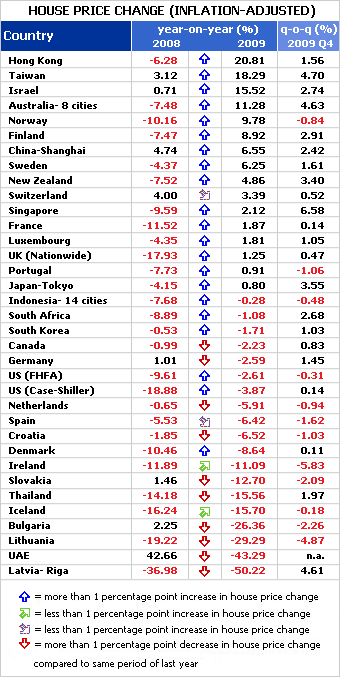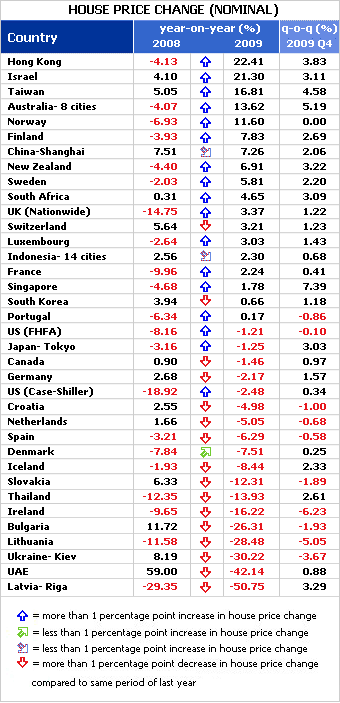The world’s housing markets are (mostly) recovering, according to the Global Property Guide’s latest survey of residential property time-series. During the last quarter of 2009, house prices rose in 22 countries, of the 34 countries for which quarterly house-price statistics are available, and fell in only 11 countries.
However, if we look at year-on-year figures, 2009 has not been a happy year. During 2009, 18 countries’ housing markets experienced price declines, while only 16 countries experienced house price increases.
 In other words, though the last two quarters suggest that recovery is now taking place, in most countries house prices are down on the year.
The Global Property Guide’s statistical presentation uses price-changes after inflation, giving a more realistic picture than the (more upbeat) nominal figures usually preferred by real estate agents.

|
| Source: Various series, data descriptions and sources here |
Recovery uneven - downturn continues in much of the world
Even in the limited sense described above – a Q3 and/or Q4 recovery - the present recovery is uneven. Some countries in Asia are rapidly recovering. But housing markets in some of the world’s worst-hit countries have continued to decline.
Hard-hit Lithuania and Ireland’s housing markets fell sharply during 2009 (-29.29% in Lithuania, and -11.09% in Ireland), and during 2008 (-19.22% in Lithuania, and -11.89% in Ireland). The last quarter offered no respite to either country (-5.83 in Q4 in Ireland, and -4.87% in Q4 in Lithuania).
Ireland’s latest quarterly drop of -5.83% is the worst since the Irish time-series began.  Back in the boom years, Ireland enjoyed steep house price appreciations, peaking at 26% during the year to Q1 1999.  Now there is still no sign of respite. The economy shrank 7.4% y-o-y to Q3 2009. Irish unemployment increased to 11.6% in 2009, from 6.4% in 2008.
Bulgaria’s housing market was badly hit during 2009 (-26.36%), and its house-price decline continued during Q4 (-2.26% on the quarter).
Slovakia is another country which experienced a steep decline during the year 2009 (-12.70%), and whose housing markets were still heading down in Q4 (-2.09%).
Spain is a similar case, added to which Spanish statistics are widely believed to understate its house-price declines. By end-2009, Spanish houses were back to their 2004 values. House prices fell 6.42% during 2009Â and 1.62% during the last quarter.
Portugal’s recovery in mid 2009 proved to be short-lived. House prices were up by a meagre 0.91% in 2009. But over the last quarter of the year, house prices were down by 1.06%. Portugal, like Italy and Germany, is something of a special case, because these countries entirely missed the housing boom that swept through the world.
In Kiev, Ukraine, house prices fell 30.22% during the year and 3.67% during Q4 2009. Kiev had enormous increases during the boom years, peaking at 75% y-o-y to Q3 2005. Figures for Ukraine are in nominal terms.
Russia’s housing market has been in crisis since Q4 2008. Over the year to Q3 2009 (the latest quarter for which data is available data), house prices in Russia dropped by 19.97%.
House prices in Greece (data is for cities outside Athens) declined by 1.39% y-o-y to Q3 2009 (the latest quarter for which data is available).

|
| Source: Various series, data descriptions and sources here |
Respite from the catastrophe
The biggest price-declines in the world during this crisis have taken place in Riga, Latvia (down 50.22% in 2009, after a fall of 36.98% in 2008), and in Dubai, UAE (down 43.29% in 2009, after a surge of 42.66% in 2008).
Both Latvia and UAE are now enjoying modest recoveries, with rises of 4.61% in Q4 in Riga and 0.88% in Dubai. Dubai’s figure is stated in nominal terms because inflation-adjusted quarterly figures are unavailable.
Slow recovery in America
In the United States, house prices fell by 0.31% (seasonally-adjusted and inflation-adjusted) in Q4, or by -2.61% over the year 2009, according to the FHFA’s purchase-only index, the most authoritative US index.
This downward movement was something of a surprise. However what really matters is that the annual house price depreciation was less during the year to this quarter, than in the year to each of the previous four quarters – i.e., the direction of change has been increasingly positive.
The seasonally-adjusted Case-Shiller index rose by a meagre 0.14% during the last quarter of 2009, and fell 3.87% during the entire year of 2009. But again, this was in the context of an overall improvement in momentum, as measured by y-o-y figure as taken each quarter, so that the Case-Shiller index also shows an improving situation in the US.
Canada experienced a house price decline of 2.23% during the year to end-2009. However, the house price index stopped falling in September 2009, so recovery is in progress.
Much of Latin America is experiencing a house price boom, but, with the partial exception of Colombia and Argentina, Latin American countries publish no house-price data.
Some booms in the Middle East
Israel’s house prices have been rising strongly ever since Q4 2008. During 2009, prices rose 15.52%, the highest increase in 10 years. Israel ranked third in this quarter’s survey.
Lebanon is also enjoying a house price boom, though it has not yet published figures for 2009.
Asia-Pacific continues to rally
Hong Kong and Taiwan have been Asia’s top two performers. Hong Kong’s house prices are back above pre-crisis levels. Hong Kong’s housing market experienced a quick turnaround when prices surged 20.81% during the entire year 2009, after suffering from a 15% decline in the first quarter of 2009. In Taiwan, house prices were up by 18.29% during 2009 and 4.70% during Q4. Investors’ confidence in the Taiwanese market has significantly improved, after a number of economic agreements were signed with China.
In Singapore, after a painful decline in 2008 (-9.59%), the year 2009 was a roller-coaster for the housing market. After price-falls in the first half of 2009, Singapore’s house prices surged 14.30% in Q3 2009, and 6.58% in Q4. During the entire year, house prices were up 2.12%.
The Singaporean government was quick to react against speculative buying by tightening credit rules, introducing a seller's stamp duty, and lowering the loan-to-value limit for housing loans.
Australia and New Zealand have sustained the increases they experienced during the middle of 2009. Australia’s house prices increased by 11.28% during 2009 (4.63% during Q4), while New Zealand’s increased by 4.86% (3.40% during Q4).
Recovery is coming slowly to Japan. The average price of existing condominium sales was up by a meagre 0.80% during the year to end 2009. The increase is only evident when prices are adjusted for inflation. However, there was an increase of 3.55% during Q4.
Thailand’s house prices slumped by 15.56% during 2009, but rose by 1.97% during the last quarter.